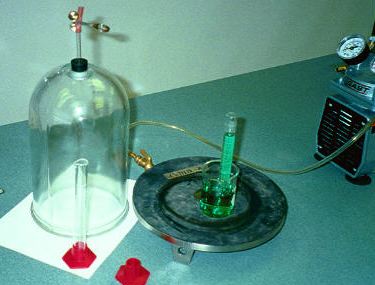

|
Materials
(pictured below) vacuum pump with bell jar apparatus, glass graduated cylinder (I used a 25 ml), water, food coloring, beaker or similar container, tape if needed 
Procedures 1. Put several drops of food coloring and about 100 ml of water into the beaker. The food coloring simply makes it easier for the students to see the demo. 2. If the cylinder has a removable plastic base, remove it. Pour some colored water from the beaker into the cylinder, leaving 2-4 cm of space at the top. 3. Set the beaker onto the bell jar platform. Place a finger over the graduated cylinder, invert it and set it into the beaker as shown in the photo. You may need to use some tape to keep it from tipping over. 4. Place the bell jar over the beaker and turn the vacuum pump on. As the pressure inside the jar decreases, the height of water in the cylinder will fall. Once the height has dropped several cm. shut the pump off and slowly let the air back into the chamber. As you do so, the height will increase. Explanation As the vacuum pump is turned on, the pressure inside the jar decreases. This lessens the pressure on the surface of the water in the beaker. The air trapped in the cylinder begins to expand, pushing the water in the cylinder downward. Discussion 1 . The reason mercury is used in barometers is that its density is so high. (Lead would float in mercury!) If water were used, the barometer would have to be unreasonably tall. 2. The lowest sea-level pressure ever recorded was 25.69 inches of Hg, measured on October 1979 in 'Typhoon Tip" northwest of Guam. The pressure is likely lower in tornadoes, but tornadic winds would destroy barometers. The highest sea-level pressure ever recorded was 32.01 inches in Siberia on December 31, 1968. It was associated with an extremely cold air mass (American Meteorological Society pages 81-82). 3. During an elevator ride up the Sears Tower (1,707 feet tall) in Chicago you would experience a pressure change of 1.7 inches. The pressure at the top would be similar to what you would experience near the center of a hurricane with 110 mph winds (Williams page 33). 4. If you have a quality pump and a good seal, you will be able to get the water to boil at room temperature inside the bell jar. This demonstrates how atmospheric pressure affects the boiling point of water. At higher altitudes water boils at lower temperatures, therefore it takes longer to cook things. If you were to boil potatoes on Pikes Peak in Colorado it would take a long time because 14,000 feet above sea level, water boils at a measly 86 degrees Celsius. In Seattle the "spuds" would be boiling in water that is 100 degrees C. Sources American Meteorological Society. DataStreme Study Guide. The DataStreme Project, 1996. Williams, Jack. USA TODAY: The Weather Book. New York: Vintage Books, 1992.
|

 |
Back to RODNEYS HOMEPAGE for Earth Science Teachers |